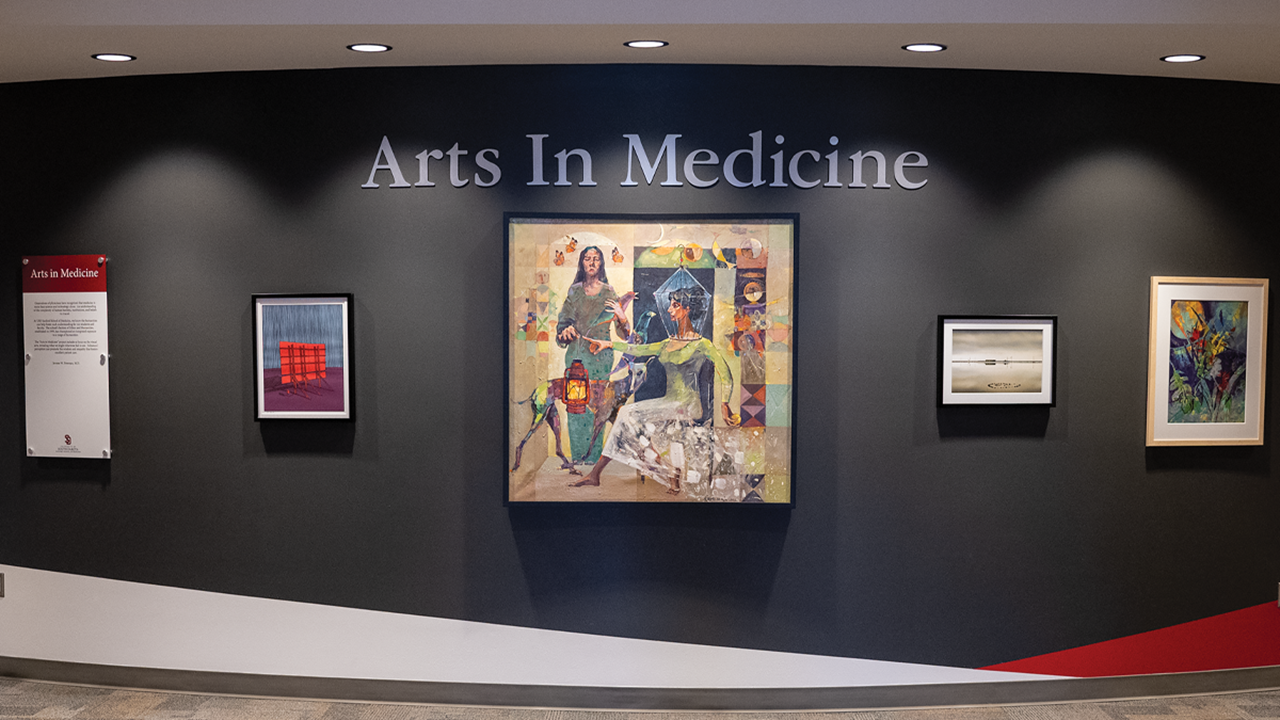Arts in Medicine Project Enhances Spaces

According to the Association of American Medical Colleges, “Arts and humanities are essential to the human experience and their benefits to medical education go far beyond joys and pleasures. By integrating arts and humanities throughout medical education, trainees and physicians can learn to be better observers and interpreters; and build empathy, communication and teamwork skills, and more.”
At the University of South Dakota Sanford School of Medicine, common spaces of the Health Science Center (HSC) have been transformed into welcoming galleries that display rotating artwork, designed to promote observational skills, empathy, cultural awareness and well-being. The school’s Section of Ethics and Humanities, established in 1995, has steered the project, with Dr. Jerome Freeman, chair of neurology, at the helm.
“The Arts in Medicine project includes a focus on the visual arts, revealing what we might otherwise fail to see,” Freeman explained. “Enhanced perception can promote the wisdom and empathy that fosters excellent patient care.
“Generations of physicians have recognized that medicine is more than sciences and technology alone,” he continued. “An understanding of the complexity of human burdens, motivations and beliefs is crucial.”
Approximately a dozen pieces of art are displayed on the HSC first floor’s signature curved wall and adjacent walls, which are painted a background of USD red, white and gray. Most pieces are created by artists with local ties, featuring several by Ethiopian painter Eyob Mergia, who is known for the creation of several murals around the city of Sioux Falls. His work is also on display at other Sioux Falls locations such as the Sioux Falls Regional Airport and Our Savior’s Lutheran Church.
Of his work, Mergia said, “I always make the connection between art, literature, philosophy, nature and human existence. Art serves as a spiritual guide. It manifests my vision and allows me to express my inner voice, and helps me raise questions about justice, truth, beauty, courage and fairness. It’s an exercise that reveals many ironies, one that helps to refine the soul. Art is like daily bread for the soul.”
Although he currently resides in Las Vegas, Mergia considers Sioux Falls his hometown. His mother was an artist, and his father a physician. As an homage to his father’s influence, Mergia says he always ensures his human faces and bodies are anatomically accurate. His mother’s influence also runs through his art, as seen in his use of animals and shapes.
“Art made in collaboration gives a common reference and shared event,” Mergia said. “Home equals comfort, love, acceptance, a sense of empathy and kindness. It feels good to overcome your own challenges and still help others with theirs.”
Other artists featured in the building include Bill Feterl, Deborah Mitchell, Seth Harwood, Diana Behl, Michael Baum and Steve Babbitt, as well as rotating installations by faculty, staff and students. Seven pieces were a gift to the medical school from Ray Graham III, purchased from the ninth South Dakota Governor’s show in Rapid City in 2021; seven pieces are on loan from Freeman’s personal collection, while Mergia gifted nine pieces to the school.
The collections are curated by Sioux Falls-based artist Sheila Agee, who collaborated with Freeman to transform the common spaces. Agee, former director of the Visual Arts Center at the Washington Pavilion and the Civic Fine Arts Center, is familiar with most of the artists featured.
“In the future we will continue to invite artists in and discuss their pieces and their thought processes,” Agee said. “Enhancing our everyday environment helps medical students and physicians by exposing what they’ve learned to refine their skills. In the end, it’s all about improving their diagnostic skills.”



